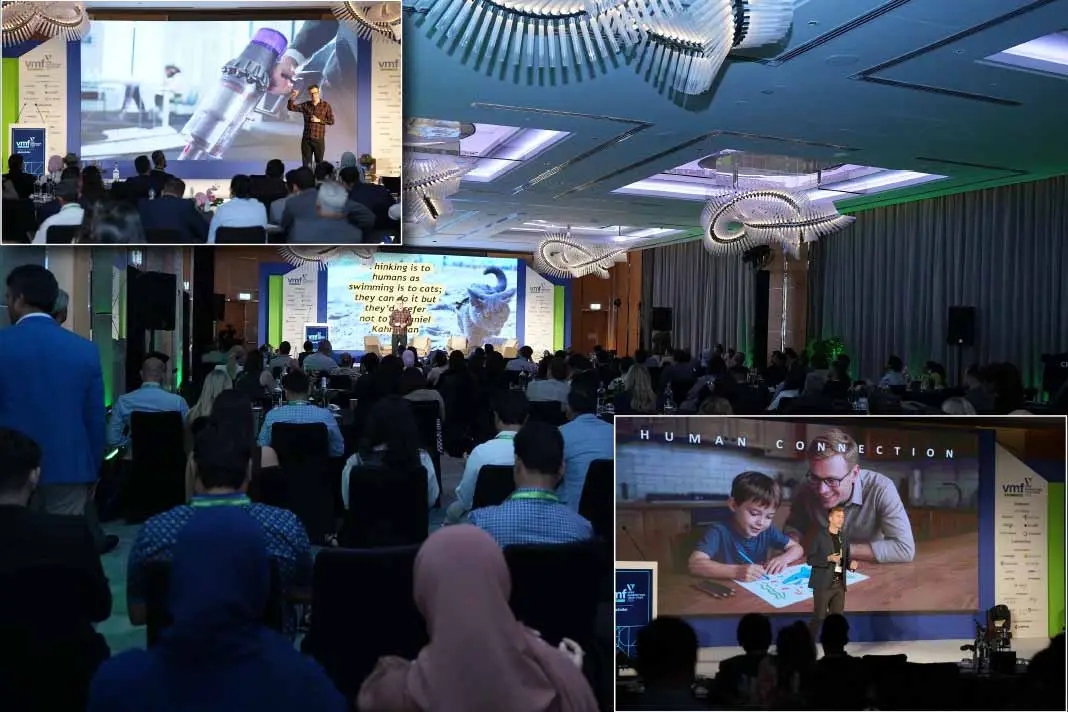From the Advisory Board: Marketing Priorities Shaping 2026
From AI co-pilots to human judgment, VMF advisory board leaders reveal the marketing priorities shaping 2026, the over-hyped...
By Anushka Pandit

The 16th edition of the Vibe Marketing Tech Fest is underway in Dubai. Watch this space as the VMF team shares highlights from the summit.
It’s an exciting time to be a marketer—which was just the vibe on day one of the Vibe Marketing Technology Fest in Dubai. KPIs are changing, the marketing-AI duo is now a tag team, and marketers are jumping into the wilderness that is human psychology to craft and shape their ad campaigns.
Held at the Hilton Dubai Palm Jumeirah, UAE, the conference was packed with marketing professionals, C-suites, decision-makers, and thought leaders.
In case you missed it, here’s a quick recap of the conversations;
Marketers today are stuck between generating ROI on the one hand and building brand reputation on the other. In the meantime, budget constraints aren’t going anywhere. With tight budgets and tighter timelines, how can marketers choose between investing in present growth for the business and fuelling long-term returns? They should not—they should balance both, or risk falling flat.
In the panel discussion Performance vs. Brand Building: How to Strike the Right Balance, experts Alyza Beg, Group Chief Marketing and Communications Officer at Easa Saleh Al Gurg Group, Haris Javed, Global Director of Marketing – Careem Rides at Careem, Sevgi Gur, Chief Marketing Officer at Property Finder, and Sharad VK, Marketing Director at Century Financial took the stage to offer insights into overcoming the short term vs. long term hurdle and driving sustainable marketing success.
“The moment we start building a brand like a performance-multiplier and not a cost centre—even if that means stepping away from traditional metrics—you will get leadership buy-in,” said Javed, emphasising how this helps step away from having to choose between short and long term growth goals.
Beg said this is “not a dichotomy,” but about striking a balance between both. “If you have a good long-term vision, short-term goals will give us better impact. The key things to keep in mind are brand strategy, product differentiation, anticipating your audience’s needs opposed to simply being reactive, and letting data be the decision-driver,” she added.
“Something we often underestimate the importance of is ‘what does the brand stand for?’ Before measuring anything, you must ask yourself how your brand is different from competitors. What’s difficult is then sticking to this definition in the long-term,” said Gur. “Then you measure whether customers are seeing what you want them to see—this value makes you a brand, without which you are just a product,” she added.
Marketers study all kinds of customers and observe a range of behaviours, some of which make sense, and some simply don’t. What helps marketers get meaning out of irrational behaviour is the science of human behaviour. By tapping into how people actually think, feel, and decide—not how they say they do—marketers can design smarter campaigns that subtly steer choices and boost conversions.
In fact, simple nudges can boost conversion rates by up to 15%. Richard Shotton, Best-Selling Author & Behavioral Marketing Expert and Founder at
Astroten, presented an awakening keynote on The Enduring Power of Behavioural Science, taking the attendees through the wonders behavioural insights can bring to campaigns.
“When people make decisions, they don’t make them as individuals—they are deeply influenced by what others are doing. So our core task as a marketer is – whatever product you want to sell or behaviour you want to encourage, you make it look like it’s popular – it will become more appealing,” said Shotton.
In his interactive session, Hacking the Human Mind: How to Give Your Marketing a Behavioural Science Superboost, Shotton also delved into the behavioural biases that shape consumer behaviour, and how marketers can apply these insights to drive real engagement.
Shotton expanded on behavioural science, saying that “it is the study of how people actually behave and what actually influences them, rather than what they claim influences them,” which are two very different things, he added.
AI has become the pocket tool for marketers, but the concern remains: marketers fear losing the human touch in their campaigns and other customer-facing communications, and rightly so. Customers tend to abandon brands whose communication feels unauthentic or robotic. The human vs. machine debate is active in all marketing boardrooms.
In the panel discussion, How Can Marketers Prepare for the GenAI Revolution? Experts Haris Khan, Vice President – Growth at Rain, James Dutton, Chief Product Officer at UM MENAT, Nandakumar Vijayan, Global Director, Marketing & Communications at LuLu Group International, Roxana Nicolescu, Vice President of Brand Marketing & Social Media at Wego, and Khadija Huseynova, Director of Communications and Content at Global Hotel Alliance addressed the challenges facing most marketers today—making the most of AI while maintaining a balance between creativity and automation.
“In 2025, the marketers’ biggest challenge is fighting the battle against bland AI-powered marketing where brands fight to escape the trap of cookie cutter algorithms where weak prompts lead to weak ideas,” said Dutton.
From best habits for creating sticky apps to crafting the perfect omnichannel strategy, Vibe Marketing Technology presented a bucket of sessions rounding up the “in-trend” of the martech landscape.
Rishi Gupta, Regional Director – Middle East & Africa at Nothing took the stage to talk about how Nothing redefined visual branding using bold design, immersive content, and a distinct aesthetic to capture global audiences. “There is a fine line between a good and a great product – which lies at the intersection of human warmth and technical warmth,” said Rishi.
Delving into visual branding, he added, “Our product launch last year was for a product designed by a community. From marketing and packaging to visual content like product design and colour—everything was designed by the community, which we then developed and commercialised,” explaining how an open and transparent culture with envisioning community as team members has aided Nothing’s growth.
Omais Waiz, Performance Marketing Director at MultiBank Group spoke about nurturing long-term app retention, and driving consistent revenue from mobile apps.
Explaining that ‘trigger’ is the entry point to habitual behaviour, Waiz said, “When you create content, context is important. For example, when you are hungry and a food app gives you a push notification at that time.” Actions, he continued, should require minimal effort. “If the app knows the customer’s preference, the customer can easily continue their journey by landing on the relevant page from the ad.”
Shedding light on the creative conundrum, Will Snow, Associate Director Digital Technologies at Yum! Brands examined whether AI serves as a powerful tool to augment creative expression or challenges the irreplaceable role of human imagination.
Breaking down the basics of prompt engineering for AI models, Snow said the ideal prompt should consist of “a subject, a scene, composition, lighting, style, and an angle.” Displaying a prompt and the generated result, he said, “It’s not what I wanted—that’s the thing with AI–it won’t always give you exactly what you want. Often, you need a creative artist to help you. That’s why humans are still doing 80% of the thinking, the doing, the steering—AI is the tool.”
With another prompt that did generate a satisfying result in the form of a brand product ad, he said that it was achieved “without a camera and a crew, and just an idea and AI—but it still needed storytelling and brand essence.”
In a tech talk on navigating the future of media, Yasmine Al Turk, Advanced DOOH & Digital Supply Lead at GroupM Nexus, Joshua Mathias, Head of Media & Digital Middle East & Africa at Huawei Consumer Business Group, and Ashnee Thacker, Associate Account Director at The Trade Desk shared key insights on how brands can harness the power of multiple touchpoints, integrating online and offline media seamlessly to achieve measurable success.
Beyond the big ideas and trend forecasts, tech talks at the conference offered a glimpse into how brands are putting martech to work in the real world. With less theory and more proof, these brands highlighted how the right mix of technology and creativity can turn bold strategies into measurable success.
Heba Al Nabulsi, Account Technology Strategist at Emplifi emphasised in her session that traditional social media metrics don’t tell the full story, and that a unified approach to analytics is essential. Another session with a focus on AI was presented by Orlando Beakbane, Principal Customer Success Manager, Enterprise at Braze, who expressed that in the age of AI, what truly stands out is humanity in action!
Sanjay Raturi, Sales Lead EMEA at AppsFlyer equipped the attendees with fresh ideas and hands-on strategies to elevate their app’s performance. Leaning into channel integration, Charles F Manning, Chief Executive Officer & President at Kochava, delved into the powerful convergence of mobile, connected TV (CTV), and digital out-of-home (DOOH) media, revealing how these channels can work in harmony to deliver a seamless and impactful customer experience.
“We no longer live in a one-device-to-one-user world. Consumers have multiple connected devices across mobile, tablet, CTV, web, and beyond. To fully understand the user journey and path to purchase/conversion, you need a cross-platform measurement strategy,” said Manning.
Speaking of driving growth, Riyad Khalil, Director – Middle East and North Africa at Adjust, explored data-driven approaches to enhance engagement, optimise campaigns, and drive measurable success in a competitive landscape.
“The biggest shift we’re witnessing is the move toward privacy-first marketing while maintaining performance efficiency,” said Khalil.
“As regulatory changes evolve and user expectations around data privacy grow, marketers need to rethink attribution, measurement, and engagement strategies. At Adjust, we’re pioneering privacy-centric measurement solutions, leveraging SKAN, Privacy Sandbox, and AI-driven insights to ensure advertisers can make informed decisions without compromising user privacy. Our focus is on incrementality measurement and predictive analytics, helping brands drive sustainable growth in the next generation of attribution and analytics,” he added.
Come back tomorrow for more. Day 2 of VMF will celebrate brands like Spotify, Kia, Storytel, Landmark Group, Careem, Alshaya Group, and more by learning about work behind the scenes that drives their winning campaigns. To see the full agenda, click here.
From AI co-pilots to human judgment, VMF advisory board leaders reveal the marketing priorities shaping 2026, the over-hyped...
Sports in KSA is now about belonging, interaction and national pride, says Adeel Ahmed Bokhari, Senior Director, Brand,...
John Speers, Joint Managing Director Middle East at MSQ, believes in tapping into the human essence of a...

GEOMOTIVE is a Digital Out-of-Home (DOOH) advertising suit that provides clients with transparent, innovative tools for planning and running advertising campaigns.
The company brings LED screens into a single, accessible platform, enabling brands and agencies to manage out-of-home advertising as efficiently as they do across digital channels. GEOMOTIVE offers precise targeting, automated media buying, and analytics tools that measure results and improve campaign performance.
GEOMOTIVE was created to transform how businesses manage and optimize their advertising investments. The company is headquartered in the United Kingdom and is actively expanding across Central and Western Asia, as well as European markets.
Today, GEOMOTIVE is a suite of modern technologies designed to make out-of-home advertising as effective, transparent, and convenient as possible for clients.

Parul Khanna is Marketing Director at Grandiose Retail and Foods, a proud Home grown UAE brand.
She is a customer centric marketing professional with diverse experience in P&L management, Brand strategy, Marketing & Customer strategy across FMCG and Retail.
Her experience in B2B, B2C and e-commerce makes her well-rounded Onmichannel professional with diverse assignments in Global organizations across UAE and India.
She has successfully launched and scaled up multiple retail businesses and led transformation projects with end to end strategic leadership and project execution.
Keen observer of shopper behavior, she continues to shape business strategies in sync with evolving consumer needs.

Zeotap is the AI-powered Customer Data Platform that helps enterprises unlock the true value of their customer data – faster, smarter, and with enterprise-grade precision. With plug-and-play connectors and a flexible, modular design, Zeotap integrates effortlessly into existing ecosystems, delivering 3x faster time-to-value than traditional CDPs.
Trusted by leading global brands, Zeotap combines the industry’s most advanced ID Extension and identity resolution with AI-powered orchestration – enabling unmatched match rates, smarter segmentation, and real-time activation. Designed for business teams and loved by IT, Zeotap makes it easy to unify, activate, and scale customer data – while staying fully compliant with global privacy regulations.
Smarter data. Stronger outcomes. Built for business.



Gaurav is a marketing strategy and brand communications leader with 19 years of experience across digital and traditional marketing. He has worked with some of the world’s most recognised consumer brands, including Domino’s, Pizza Hut, Dulux Paints, Marico, and Whirlpool, leading marketing, brand building, new product development, and media strategy across the Middle East, North Africa, and India.
With global experience spanning Food, QSR, Retail, Durables, and FMCG, Gaurav has built differentiated, high-impact brands that have driven strong top-line and bottom-line growth. He is known for championing digital- and social-led marketing while balancing modern performance strategies with traditional brand-building principles.
Gaurav currently serves as the International Marketing Director for Domino’s Pizza in the AMEA region.


Mohamed Al Awadhi is a marketing leader with over 16 years of experience aiming to deliver culturally resonant campaigns. His work includes the relaunch of Modesh, the development of the Dubai Home Festival branding, du’s first Emirati-focused Family Plan campaign and FAB’s first Elite segment campaign. As VP of Personal Banking Marketing at First Abu Dhabi Bank, he drives customer-centric strategies that blend data-driven insights with compelling storytelling. As a previous mentor at Sheraa and DIFC Innovation Hub, Mohamed brings deep expertise in brand strategy-combining rigorous research with imaginative thinking to build brands that shape culture and connect meaningfully with audiences.

Jean-Paul Smalls is a senior marketing and commercial leader with over two decades of experience driving growth, digital transformation, and brand strategy across healthcare, technology, and consumer sectors. He currently serves as the Chief Marketing & Commercial Officer at Emirates Hospitals Group, where he oversees group marketing, business development and call center operations.
Previously within the healthcare industry Jean-Paul has served as the Chief Communications & Digital Officer at Clemenceau Medical Center Hospital – Dubai, and Head of Marketing & Call Center Operations ar King’s College Hospital London UAE.
Prior to his healthcare career Jean-Paul spent over a decade working in startups both in the UAE and his native England spanning both agency and client side in media buying, recruitment tech, social ecommerce and consultancy. His expertise covers full-funnel marketing, growth strategy, talent acquisition, AI for marketing, advanced digital marketing, SEO/SEM, and brand building.

Hira Aamer serves as regional Brand Strategy Director for Sprite at The Coca‑Cola Company. With over 12 years in marketing & leadership roles at Unilever, and consulting, she has built expertise in brand strategy, innovation, and culturally resonant communication. An Oxford graduate in Economics and Management, her superpower is integrating strategic vision with precise execution. Hira champions consumer‑centric marketing that seamlessly blends creativity and analytical rigor, delivering impactful brand and business growth in complex, fast‑changing markets.

Nina Mohamed is an award-winning hospitality marketing and communications leader with over 15 years of experience across the Middle East and Asia. Renowned for her creative storytelling, data-driven strategy, and guest-centric approach, she has shaped the brand identity of some of the region’s most recognisable island-resort destinations.
As Cluster Director of Marketing & Communications at Mövenpick Resort Al Marjan Island and Pullman Resort Al Marjan Island, Nina has elevated both properties into top-performing family-island destinations. Under her leadership, the resorts have won more than 40 international, regional, and local awards since 2023, including multiple World Luxury Awards, FACT and What’s On accolades, and sustainability recognitions. Several of her brand campaigns and toolkits have been adopted as best practice across the Accor MEA APAC portfolio.

Roxana currently serves as VP Brand Marketing & Social Media for Wego. With more than a decade of marketing experience in the region, most of it in the aviation and travel industries, she passionately drives the brand marketing activities and brand awareness growth in the Middle East Roxana began in this role in October 2017 in Wego’s Dubai office where she focused on developing Wego’s Brand Marketing department as well as played a significant role in expanding the brand footprint across the region. Over the years, Roxana has worked for several well-known brands in various industries, including aviation, media, and travel tech. Her expertise includes brand strategy development, product positioning, market research, and marketing communications. Roxana has also developed an impressive track record in building brand equity through effective brand management.


Growth and Analytics Leader who has scaled unicorns, driven IPOs, and ran cross-country P&Ls across MENA, SEA, EU, and India. In the past, he has built, led and shaped Growth teams at GoJek, Airtel and P&G. Known for building high-performance org. cultures grounded in data discipline, experimentation, strategic clarity, and bold but measured risk-taking.

With 18 years of experience in digital transformation, eCommerce, and supply chain innovation, Arjun Sarkar is a key driver of technological advancements in the digital commerce sector. As Vice President of Digital Ecosystem and Partnerships at Dubai CommerCity, he leads the development of a robust digital ecosystem that empowers businesses to scale and succeed in the Middle East’s thriving eCommerce market.
Arjun has a strong background in software engineering and business strategy, having spearheaded the digital transformation of global brands such as Marks & Spencer, Toys R Us, Ace Hardware, and Lancôme. His expertise in omnichannel retail and technology-driven solutions has enabled brands to optimize operations and enhance customer experience.

Mohamad Al Rayes is a product and growth leader with deep experience across digital marketplaces, AI-driven platforms, marketing technology, and large-scale product optimisation. He specialises in transforming user journeys, scaling acquisition funnels, and building data-powered experiences that drive measurable growth.
His expertise spans product strategy, UX/UI leadership, performance marketing, growth hacking, and designing intelligent systems such as AI sales agents, smart search experiences, and dynamic customer platforms. With a strong background in AI, automation, and user-centric design, Mohamad is known for bridging strategy, technology, and experience to create high-performing digital products.

George Yaryura is a global Chief Marketing Officer and Brand & Growth Strategist with over 25 years of leadership across financial services, fintech, PropTech and telecom. He transforms strategy into measurable growth—building brands that lead, marketing engines that deliver revenue, and communications that inspire confidence. George has driven transformation for global organisations, including Mashreq, Visa, Allfunds (Santander), Skype, and Orange, supporting 8–9 figure revenue goals, M&A, and IPOs. A published author and patent holder in tokenisation, he brings entrepreneurial energy, multilingual fluency, and board-level expertise to scaling high-growth businesses across MENA, Europe, the U.S., and Asia.

Álvaro Martínez is a dynamic growth leader with a proven track record driving expansion and pricing innovation in fast-moving consumer digital businesses across LATAM, Europe, the Middle East and Africa. With a strategic mindset grounded in data-driven insights, he has led market-entry and scale-up initiatives that have redefined customer acquisition, monetisation and competitive advantage. At Talabat and InstaShop, Alvaro oversees multi-channel growth strategies, pricing models and partner ecosystems to deliver sustained profitability and regional leadership.

Joy Dabeet is the Chief Marketing Officer at amana. Leveraging her 15 years of industry experience, she steers every facet of amana’s marketing strategy and implementation. A key aspect of Joy’s responsibilities is to strengthen amana’s position as the leading neobroker; scaling the brand and driving its growth across the region. As a data-driven marketer, she runs a fully in-house marketing team which includes performance marketing (acquisition, CRM, SEO, data analytics), brand communications, content creation and design. Her team’s data and performance analysis also support other departments from sales and customer service to operations and finance.

For the past years, Ahmed has been helping brands across the Middle East, Africa, and Near East truly connect with their customers. As an Emarsys Advisor, he works side-by-side with marketing and CX teams to turn data into meaningful conversations delivering the right message, on the right channel, at the right time. His passion lies in creating personalised, omnichannel experiences that don’t just drive sales, but build trust and loyalty. Ahmed believes that great customer engagement is less about technology and more about understanding people and using the tools to bring that understanding to life.

Vollin Braganza is an experienced sales and growth leader with a strong track record across top global brands, a results-driven and growth-oriented professional with a passion for driving digital transformation through modern technology. With over 8 years of experience in the B2B SaaS space, he specializes in helping businesses scale across industries—E-commerce, Fintech, Banking, Real Estate, Edtech, and Healthtech.
At MoEngage, Vollin leads strategic growth initiatives across the MENA region, helping B2C brands unlock customer value through insights-led engagement.

Yolande is a journalist with over 15 years of experience reporting on technology across both enterprise and the start-up landscape. Since 2015, she has been hot on the trail of covering artificial intelligence, exploring its evolution from emerging innovation to global disruptor. Her conversations with C-suite data and tech decision-makers globally gives her insights into leading marketing strategies, trends, and policy decisions shaping the future of work, business, and life as we live it.

Haris Naeem is a Senior Account Executive at Braze. Haris has been with Braze for 3.5 years and was the first dedicated hire in the region, managing key client relationships and helping drive customer success and growth. Outside of work, Haris has a passion for history, film photography and playing padel.

Alannah Higgins looks after the leading Brands in the GCC region who use Braze to power their omnichannel customer experience. Alannah helps MarTech & Product leaders evaluate how they can take their CX strategy to the next level, and what technologies are best placed to deliver their business objectives. She is passionate about great customer experience and is located between Dubai & Riyadh, working for Braze’s go to market team.

Victor Busnel is the Trading Director for MENA at the Trade Desk, responsible for helping clients take advantage of the various tools and features the Trade Desk’s platform has to offer, helping brands and agencies get the most out of their programmatic media spend. After spending 3 years at The Trade Desk in the UK, Victor started working on developing the company’s business in MENA , and is now based in Dubai with a full focus on growing programmatic for the region. Prior to Joining The Trade Desk, Victor worked in consulting at The Boston Consulting Group helping clients optimize their marketing strategies, and in marketing roles at L’Oréal and NBCUniversal.

Simon is a globally recognised creative leader and strategic communicator. He is the Chief Communications & Marketing Officer at the King Salman Park Foundation – one of the world’s most ambitious and transformative urban regeneration projects set in the heart of Riyadh, Saudi Arabia. Formerly Global Chief Creative Officer at creative & strategic communications agency, Burson and Global Chief Creative Strategy & Innovation Officer at Hill & Knowlton, Simon led the creative transformation across the US, Middle East, China, and Europe. He blends strategic and design thinking with creative expertise to drive innovation, growth and transformative change, earning multiple Cannes Lions and top creative rankings in PR Week. A sought-after speaker and juror at Cannes Lions and D&AD, Simon is known for building creative cultures that inspire, connect, and transform.

Wasif is a result-driven Global Transaction Banking Leader and Innovator. In a career spanning over 25 years, he has played a key role in building and growing Trade, Supply Chain Financing (SCF) & Transaction Banking business, grounds-up, in multiple local & international banks. He has also been instrumental in banks becoming market leaders in Trade & Transaction Banking solutions based on the strength of their customer-centric products, distinguished user-experience and marketing prowess.
Wasif possesses proven expertise in establishing & managing both Business & Digital Technology. He is the trusted go-to person for leading strategic initiatives, digitalisation, technology transformation programs, FI/Fintech partnerships and sophisticated solution sales.
His alma maters include MIT Sloan School of Management and KFUPM.

Julian Morbidelli is a loyalty and rewards executive with over 15 years’ experience across the Middle East and Africa. He spent a decade with the ENTERTAINER, a leading provider of incentives and loyalty reward solutions, where he held senior leadership roles including General Manager for Saudi Arabia.Today, as Director of Loyalty at Cenomi Centers, he is shaping the launch of Cenomi Plus Loyalty, a new programme designed to engage the 130 million in annual footfall. Julian is recognised for creating ecosystems that engage and connect customers in unique ways while building commercial models that drive rapid and sustainable growth.

Mohamed Hegazy is the Chief Experience Officer (CXO) at almatar Group, leading customer-centric innovations in the travel industry. With expertise in CX, UX, VOC, and loyalty programs, Mohamed has driven significant NPS growth, retention, and self-service adoption.
Passionate about digital transformation, he has implemented Al-driven personalisation, gamification, and proactive engagement strategies.

Hany Mokhtar, known globally as “The CX Master” or “The CX King,” is a world-class authority in Customer Experience and Digital Transformation with over 30 years of cross-industry expertise spanning utilities, telecommunications, banking, government, and technology sectors. As the creator of the internationally recognized 4Es CX defining Framework and the ICE Methodology (Continuous Improvement of Customer Experience), he has transformed how organizations approach customer-centric business strategies. His groundbreaking work has been featured in CXM World Magazine as “one of the world class speakers and thought leadership,” recognized by The Arab Icons as The CX authority.
Mokhtar is also a Harvard Business Review Advisory Council member and published academic researcher, Hany has trained over 2,000 executive level students across multiple age groups, and professions through 5,000+ hours of expert knowledge transfer.
His educational partnerships with prestigious institutions like the American University in Cairo have produced certified CX professionals, startup founders, and transformed senior executives from Fortune 500 companies including Emirates NBD, Mobily, Microsoft, and Qatar Insurance Company abs others ..
From C-Suite boardrooms to university lecture halls, from MENA & EMEA corporate leadership programs to international conferences, Hany combines deep scientific knowledge with empirical know-how implementation expertise, making him the definitive authority for organizations seeking sustainable customer experience transformation and competitive advantage.

A certified marketing professional who launched Saudi as a destination into China and India working for Saudi Tourism Authority after building and positioning the brand for PIF giga-project Jeddah Central Development. Earning over 70 awards internationally for work in Europe, Japan, the Caribbean, Americas and across Asia Pacific, John is the only person to win 3 Effie’s in travel, the benchmark on global marketing effectiveness.
After 3 years of searching for an agency that understands travel he set one up. MSQ Middle East is the only creative agency in the Middle East specialising in travel and sport, backed by MSQ one of the fastest growing agency networks in the world, closing the loop in marketing to convert travellers and bringing in significant visitation and spend into Saudi and the Middle East.

Ameerzeb is a market creation strategist known for turning ambitious national visions into financially sustainable, investable ecosystems. At the Royal Commission for AlUla, he leads the Commercial Development and Investment Promotion function, helping transform one of Saudi Arabia’s most iconic cultural landscapes into a globally relevant tourism economy.
Over the last two decades, Ameer has consistently turned white space into market opportunity. He has built new business lines, reshaped industries, and unlocked growth across some of the region’s most complex sectors. From launching the world’s first Islamic wealth platform at HSBC to structuring innovative investment models in sports and heritage tourism, his work has helped transform both institutions and entire destinations.
His approach sits at the intersection of policy, private capital, and cultural authenticity. He brings together stories and spreadsheets to design businesses and places that endure.

May is a visionary brand builder and transformation leader with over 20 years of experience shaping and scaling some of the region’s most iconic luxury and premium brands across fashion, beauty, and lifestyle. Renowned for her ability to blend strategic growth with cultural storytelling, May has led brand evolutions that connect emotionally, grow commercially, and stand out creatively.
Throughout her career, she has held senior leadership roles across top regional companies, where she spearheaded brand repositioning, omnichannel expansion, and consumer-centric innovation. Her approach merges data-driven strategy with deep storytelling to craft distinctive brand identities that resonate across physical and digital touchpoints. May is widely recognised as a cultural architect, helping Saudi-born brands express their heritage with relevance and beauty on the global stage.

A creative strategist on a mission to connect people, power up teams, and unlock business potential with AI, Bady is the product lead with Ninja, a quick commerce powerhouse in Saudi Arabia. Previously, he has led Product at MRSOOL, Haraj, Dukan and machinestalk. He holds a masters in Artificial Intelligence, and a degree in computer engineering. According to Bady, he believes in turning challenges into opportunities by blending curiosity and a human-centred approach.

Ahad is a senior commercial executive with nearly two decades of proficiency in entertainment, retail, malls, fashion, F&B, hospitality, etc. He is recognised for transforming businesses, driving profitability, and fostering long-term value through strategic partnerships with committed passion for innovation in customer engagement. In his current role, he leads marketing at SALA Entertainment. Previously, he has led teams across Abdullah Al Othaim Investment Co, Majid Al Futtaim, Rubaiyat Modern Luxury Co. LTD and many more.

Ibrahim is the Product Director at Tamara leading the Payment vertical. His role is to create a premier service by focusing on availability, risk, and cost. Prior to that, he led Foodics Pay product, a comprehensive payment solution that integrates software, hardware, and payment processing. With a background in Computer Science and an MBA from KFUPM, he possesses strong analytical, problem-solving, and leadership skills that enable him to contribute to business growth and development. He has a certification in Strategy Execution from Harvard Business School. According to Ibrahim, he has a passion to leverage his FinTech and SaaS expertise to create innovative and impactful products that solve real-world problems.

Adeel is the Senior Director for Brand at the Saudi Olympic & Paralympic Committee, where he oversees the strategic and creative direction of the Team Saudi brand, celebrating the journeys and achievements of our athletes in the Olympic and Paralympic Games. Adeel has over 17 years of experience in brand, marketing, and commercial business leadership. He spent ~12.5 years at Procter & Gamble working in MiddleEast, Switzerland, Africa and Pakistan regions, launching and growing multiple brands such as Gillette, Safeguard, Pantene, H&S and Pampers – building strong background in brand equity, marketing strategy, creative ideation, consumer insights, problem solving and Business P&L Management. He has also led teams at Nahdi Medical Co., the largest pharmacy retail chain in GCC. He has certifications in corporate governance, healthcare management, and generative AI. According to Adeel, he is passionate about learning new things, building the capability of himself and others while making a positive impact in the world.

Bandar Abdulmajeed is the Chief Brand & Marketing Officer at Amsa Hospitality, bringing over 25 years of diverse experience in retail, hospitality, F&B, and entertainment. A proven leader, he has spearheaded over 2000 events, launched and rebranded over 30 brands, and established marketing departments for major companies. Known for his strategic acumen and ability to drive commercial growth and complex marketing operations, Bandar is committed to innovation, delivering impactful brand narratives, and building high-performing teams.

Mohammad is a versatile and results-oriented business and marketing management professional, with proven creative campaign leadership. In his current role as director of marketing and communications at Al Rajhi Takaful, he demonstrates strong knowledge of marketing strategy, brand positioning and relationship management. In the past, he has help prestigious roles with companies like Riyadh Holdings, Al Khozama Investment, Cenomi Centers and flynas. According to Mohammad, the experience and exposure gained with leading companies in its field has taught him the ability to quickly adapt to different marketing environments, while providing thought input and pro-active solutions.

Dr Adham brings over a decade’s experience in healthcare marketing, advertising, and communication, driving measurable business outcomes. Dr. Adham is currently the Group Marketing Director at Hayat National Hospitals under Alinma Group, leading national strategy and digital growth. With 15+ years of experience, he drives data-led acquisition, CRM retention, and brand performance. His work blends AI, analytics, and storytelling into scalable marketing systems. Google-certified and a Chartered Toastmaster, he’s known for precision execution and executive communication. He builds high-impact ecosystems that deliver measurable business results.

Talha brings 22 years of experience in the vibrant and ever-evolving hospitality industry. His journey has encompassed various aspects such as Reservations, Sales, Marketing, Revenue Management, Front Office Management, and Guest Services. For the past 13 years, he has been an integral part of Riyadh hotels, involved primarily with hotel operations and guest experiences.
In his current role as the Director of Sales & Marketing at the prestigious Radisson Blu Hotel, Riyadh Convention & Exhibition Center, he excels at driving commercial success while upholding the highest standards of service excellence.
According to Talha, his ability to swiftly discern market shifts and adapt strategies has been a cornerstone of his success. ‘By aligning business objectives with customer-centric approaches, I strive to create seamless experiences that resonate with guests and elevate the hotel’s reputation.’

Serving nearly 30% of the top 1,000 online retailers, Feedonomics is the leading data management platform powering omnichannel growth for the world’s top brands and retailers. Customers like Dell, PUMA, Fox Racing, and New Balance see dramatic results with Feedonomics, such as a 95% increase in return on ad spend and a 22% increase in annual revenue growth. With its flexible technology and full-service support team, Feedonomics facilitates a variety of data management use cases across industries such as ecommerce, automotive, employment, travel, real estate, and more. Feedonomics has thousands of active customers, integrations with hundreds of ecommerce platforms and channels, and strategic partnerships with industry leaders like Amazon, Meta, Google, Microsoft, and TikTok. To learn more about Feedonomics, a platform-agnostic BigCommerce subsidiary, visit www.feedonomics.com.

OneTrust’s mission is to enable the responsible use of data and AI. Our platform simplifies data collection with consent and preferences, automates governance through integrated risk management across privacy, security, IT/tech, third-party, and AI risks, and drives responsible data usage by enforcing policies across the entire data estate and lifecycle. OneTrust fosters seamless collaboration between data and risk teams to accelerate trusted innovation. Recognized as a market leader and pioneer, OneTrust holds over 300 patents and serves more than 14,000 customers worldwide, from industry giants to small businesses. For more information, visit www.onetrust.com.

monday.com is a work operating system (Work OS) where organisations of any size can create the tools and processes they need to manage every aspect of their work. By combining building blocks, like apps automations and integrations, teams can build or customise the workflows of their dreams. Streamline and optimise your marketing work management processes together at scale for maximum efficiency — from idea, to strategy, to delivery.

Times of AI came into existence because of the everywhere-acknowledged importance of acquiring precise and current information in the very fast-developing sector of artificial intelligence. And as much as the industry developed, reliable and factual reporting had become scarce. The platform seeks to fill the gap between expert-driven insights into the latest on AI and an uncomplicated analysis.

StartupNews.fyi is India’s leading news & technology media company that focuses on Startups in India and top stories across the globe. From the latest news to the unicorns, we cover everything that happens in Startup World. Within a short span of time we have placed a great trust with the startups & reached over 2 million enthusiasts. Whether it is the in-person meetups and international delegations, SNFYI has served the ecosystem and helped several startups and investors to connect & spread the word through a single channel.

We explore how Artificial Intelligence and Exponential Technologies bring opportunities for people, organizations, and societies to increase their wealth and health.
Our audience is anyone who wants to improve in their career, their business, their investments; who wants to live a healthier, more productive, and fulfilling life; who wants to simplify and improve the education systems of their communities, or who simply wants to understand how Exponential Technologies are changing the world.
We publish articles, podcast interviews, and ebooks with insights from industry leaders and experts, and use cases of exponential technologies across multiple fields, including finance, healthcare, and education.















The Trade Desk is a global technology company that empowers buyers of advertising. Through its self-service, cloud-based platform, ad buyers can create, manage, and optimize digital advertising campaigns across ad formats and devices. Headquartered in Ventura, CA, The Trade Desk has offices across North America, Europe, and Asia Pacific. To learn more, visit thetradedesk.com

Braze is a leading customer engagement platform that helps brands build meaningful relationships with their audiences in real time. By leveraging AI-powered personalization, cross-channel messaging, and actionable insights, Braze enables businesses to create seamless and dynamic customer experiences across mobile, web, email, and more. Trusted by global brands, Braze empowers marketers to craft data-driven campaigns that drive loyalty, retention, and growth. With a focus on innovation and scalability, Braze is redefining how companies connect with customers in today’s digital-first world. Learn more at braze.com.

ObservePoint’s Web Governance platform brings insights, automation, and compliance to the complexity of your digital experience. Our solution automatically scans your websites from the highest traffic pages and user paths to the darkest corners. See what’s performing below acceptable standards, trace it back to the source, and get on a path to improvement. Audit privacy compliance efforts, validate landing pages, confirm data tracking, monitor your entire marketing tech stack, and much more. ObservePoint presents the reality of what’s happening on your website and gives you a clear map to make it even better.

Epsilon is a global technology, data and services company that the world’s leading brands use to harmonize consumer engagement across their paid, owned and earned channels. The Epsilon PeopleCloud platform includes capabilities such as data, identity resolution, customer data platforms, clean rooms, digital media, retail media, site personalization, direct mail, loyalty, email marketing and measurement. By applying artificial intelligence against privacy-centric identity resolution–embedded in data-enriched analytic, marketing and media solutions and services—Epsilon allows marketers to bridge the divide between marketing and advertising technology, engaging consumers with 1 View, 1 Vision and 1 Voice. 1 View of their universe of potential buyers. 1 Vision for engaging each individual. 1 Voice to harmonize engagement across paid, owned and earned channels. For more information, visit www.epsilon.com.

MoEngage is an insights-led platform trusted by 1,350+ global & native brands like McAfee, Domino’s, Nestle, Deutsche Telekom, Landmark, GMG, Apparel, Azadea, Entertainer and more. MoEngage’s powerful analytics, personalization, and AI capabilities give a 360-degree view of your customers and help you create journeys across digital channels.

Brandwatch is the world’s premier social suite, empowering the world’s most admired companies to understand and engage with customers at the speed of social. Combining pioneering, AI-enriched digital consumer intelligence with industry-leading social media management tools, Brandwatch offers a complementary suite of specialized, best-in-class products and services that support intelligently connected workflows. With Brandwatch, brands and agencies can adapt and thrive in today’s fast moving digital world by making smarter decisions and executing data-driven social strategies at every customer touchpoint.

Sitecore is a global leader in digital experience software, trusted by visionary brands like L’Oréal, Microsoft, and United Airlines to power their content lifecycle from content strategy to digital experience delivery. Our composable platform gives marketers and technologists the power to build together at global scale – harnessing content, data, personalization, and AI – to manage digital assets, create engaging content, understand customer intent, and deliver standout experiences across all touchpoints. Discover more at sitecore.com.